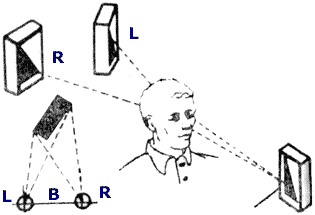
The capability of demonstrating of pictures in natural color and 3D-form with the help of different means is reaching of modern science and engineering.
Due to presence of a solid vision the man since children's years teaches subjects, ambient him, in a volume. The visual vehicle of the man can be compared (to some allowances) with an optical system of a photographic camera continuously fixing picture of situation, ambient us. Each our eye is as though lens of such camera. An eye with the help of a lens projects on a retina the flat map of a subject, and because the eyes are carried on some value (base - B), the maps of a subject receive unequal.

The difference in the obtained maps is a consequent of different remoteness of points of a subject.
In a figure is rotined, that each eye of the man surveying a subject - a box, costing on desktop, - perceives the flat map, the left-hand eye sees the map of L, and right eye - the map of item of the R.
Map of L and R differ one from another, because the left and right eyes see a subject under a miscellaneous angle. Both maps are transmitted on visual nerves in a brain and due to activity of a central nervous system and visual segments of a brain these two flat maps drain in one volumetric map of a considered subject.
This feature of volumetric perception of space will be used for reconstruction of a volumetric image of object till it to two flat maps - stereo pair.
Is apparent, that these two flat maps will create a volumetric image of object only then, when they will be esteemed selectively, that is, when each eye will see only map, intended for it. Such separation, or classification of the maps of a stereo pair, is reached, for example, applying of polarization filters. It is necessary to mark that the people with some defects of vision are dispossessed capabilities to perceive the stereomap. Large visualization of the stereomaps approaching to substantial perception of objects, embodied on them, or phenomena, capability spatially to present the shape of objects and their positional relationship in space - quality, which one enable successfully to use a stereoprojection in many areas of creative activity of the man.
Stereoprojector "FED Etude Stereo" (further in the text - projector) provides on a special screen the brightly expressed visual affect "of presence".
ATTENTION! For check projector use a monitoring stereoslide.
It is recommended to apply to obtaining stereo pairs the special stereocamera, for example "FED M Stereo".
It is possible to use and logistics stereo pairs in standard frameworks.
The format of frame of a stereo pair: |
24x30 mm |
|
The size of a framework for a stereo pair: |
100x50 mm |
|
Base of a stereo pair |
62.5 mm |
|
The format of frame of a framework: |
24x36 mm |
|
The size of a framework: |
50x50 mm |
|
Projection lenses (2 pieces): |
"Triplet" 2.8/80 mm |
|
Condenser (two-channel): |
three-lens with t°-filter |
|
Lamps type (2 pieces): |
halide lamp KGM 220-230-200 |
|
Power: |
alternating-current 220 V, 50 Hz |
|
Minimum magnification in projection mode: |
10x |
|
Consumed power at voltage 220 V, no more: |
450 W |
|
Critical dimensions (without a bracket), no more: |
308x170x140 mm |
|
Weight (without accessories), no more: |
4 kg |
Projector (with 2 lamps): |
1 pcs. |
|
Bracket for a monoprojection: |
1 pcs. |
|
Bracket for stereoprojection: |
1 pcs. |
|
Glasses polarization: |
5 pcs. |
|
Frameworks for single slides: |
20 pcs. |
|
Frameworks for stereo pairs: |
20 pcs. |
|
Plugwire connective: |
1 pcs. |
|
Box packing: |
1 pcs. |
Spares:
Halide lamp KGM 220-230-200: |
1 pcs. |
|
Safety device VP 1-1 (3A): |
2 pcs. |
|
Rim with polarization light filters: |
1 pcs. |
|
Driving belt: |
5 pcs. |
1 - cover
2 - handle of a focusing of lenses
3 - adjustment knob of lenses on a horizontal
4 - lenses
5 - handle for transportation
6 - leg adjusting
7 - adjustment knob of lenses on a vertical
8 - personnel window
9 - grating
10 - push button of actuation of the right channel
11 - push button of actuation of the left channel
12 - disconnecting switch of a power
13 - plugwire connective
14 - safety device
15 - driving belt
16 - sheave of the electric motor
17 - vane of cooling of lamps
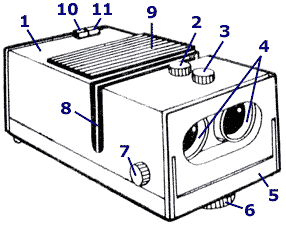
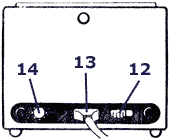
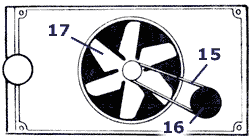
Each of two optical channels of projector consists from a reflector, halide lamp, and condenser with t°-filter, polarization filter and lens.
Due to two polarization filters arranged in a bracket for a stereoprojection, light from the right and left channels appears polarized. Other pair of polarization light filters pasted into special glasses provides separate perception of the left and right maps, and as a whole - perception by the spectator of the spatial map.
The review of stereoslides implements on a special screen.
Changing of stereo pairs - manual, with the help of a bracket with the movable keeper.
At the moment of change of a stereo pair shutters automatically overlap the channels.
In projector the capability of review of single slides is stipulated. A bracket for a monoprojection in this case will be used.
In projector there is an electronic device, which one automatically provides smoothly varying increasing (decreasing) of voltage on lamps after their actuation (cutoff). That prolongs service life of a lamp and at the expense of serial actuation of channels allows to demonstrate single slides with effect "of inflow" (gradual replacement of one map to another).
The regulation of a lead angle of projector from 0° up to 4° is stipulated.
Exposed film is necessary for arranging how it was pasted into the stereocamera. Thus the map will be inverted. To prepare frames of a stereo pair for mounting in a framework, they are necessary be for cutting up and for organizing on 180°.

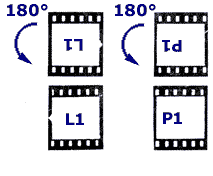
The mounting right (R) and left (L) of frames of a stereo pair in plastic frameworks is made as follows.
Free glasses from packaging and wipe by a flannel. Free frameworks also from packaging and decompose on desktop in two series on color. Insert glasses 21 in windows of frameworks 18 and 19. In frameworks of definite color paste frames of stereo pairs, for what each stereo pair paste in a slot 20 so that edges of frames of stereo pairs were parallel to edges of personnel windows of frameworks with symmetrical gaps between them. By frameworks 18 (without stereo pairs) cover frameworks 19 (with stereo pairs) and densely close before disappearance of slots between frameworks.
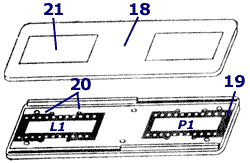
The notice: At presence on glasses fatty of spots to wipe by their wad, wetted in alcohol or aether.
The frames of a stereo pair also should be clean. In order to prevent appearance of the finger-prints and scores at rigging up it is not necessary to concern a slide by pins, forceps or other tools in a zone of the map.
It is necessary to take into account that the quality of a stereoscopic effect depends on quality of mounting.
The notice: Mounting single slides in frameworks 50x50 mm / 24x36 mm to make similarly to mounting in stereoframeworks.
Take out projector from a packing box.
For the installation projector the steady horizontal basis (desktop, cabinet) altitude 90-120 cm is necessary.
The installation site should carefully be wiped from dust, in order to prevent suction by its vane inside projector.
ATTENTION! In place of the projector installation should not be a film, a paper and other materials, which one can be attracted to the lower grid by a flow drawn in air. The projector exploitation with closed slots of the lower grid is prohibited!
Take a bracket for a stereoprojection, having paid attention that it has the movable slide keeper 22, which one is displaced inside a fixed body 23.

On a body the polarization filters and shutter are arranged. At movement of the keeper to extreme left-hand or right (working) positions the shutter opens.
At statement of a bracket in projector establish the keeper in a mean (non-working) position as shown. Paste a bracket into a personnel window by a shutter in the party of lenses. And the grips on a body of a bracket should enter the applicable grooves of the projector.
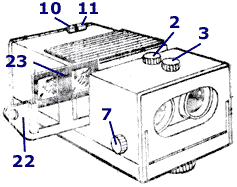
Move the keeper in any extreme position. Paste into a jack of the keeper a stereo pair 23 inverted and emulsion in the party of lenses.
Displace a bracket to other extreme position - a stereo pair now is off-the shelf to a projection.
ATTENTION! In order to prevent breaking of projector paste and take out a bracket only on the average (non-working) position.
Projector could be used and for demonstration of logistics stereo pairs in frameworks 50x100 mm and base 62.5 mm without padding mounting. Thus the logistics stereo pair should be set inverted by emulsion to the gaffer.
Switch-on cooling by moving of the disconnecting switch 12 in an extreme position. Having convinced, that the vane works, simultaneous clicking of push buttons 10 and 11 to include projector lamps.
Mate the map with a screen, using an adjusting leg.
Receive on a screen the sharp map, make a focusing of lenses by rotation of the handle 2.
Mate two pictures through handles 3 and 7 on a horizontal and vertical.
For set-up and examining the stereoscopic map dress polarization glasses. With the help of handles 2, 3 and 7 make set-up of the stereomap.
The movement of the keeper of stereo pairs from one extreme position in another provides serial replacement of the overlooked stereo pairs without interruption in demonstrating.
After ending demonstration switch-off projector lamps by mild, series clicking of push buttons 10 and 11, then disconnect projector from an electrical circuit. Establish the keeper in a mean (non-working) position and take out a bracket from projector.
Switch-on projector by the disconnecting switches 12. Paste a bracket for a monoprojection into a personnel window (is similar to the installation of a bracket for stereoprojection). The bracket for a monoprojection is furnished with two movable keepers of slides 25 and 26.

Put forward the keepers and in each of them paste on an empty framework for slides. Push-in the keepers in personnel windows and switch-on both lamps.
With the help of adjusting handles 2, 3 and 7 focus and maximum reduce both pictures in one (is enabled small stredding of pictures).
Having put forward, for example, keeper 25 remove empty framework and paste instead of it a framework with a slide 27, push-in the keeper against the stop.
Click the push button 10, thus the channel with empty framework will be switched off. Focus picture by rotation of the handle 2. At further demonstration the necessity of focusing will vanish, as the slide is between protective glasses, that eliminates its trough.
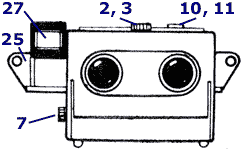
In the same way establish a framework with a slide in the keeper 26 and clicking of the applicable push button switching on other channel. Thus on a screen will happen the sluggish gang of one map by another, that will create effect "of inflow".
After ending demonstration switch-off a lamp by mild clicking the push button of an adjacent (switched off) channel. Disconnect projector from a electrical circuit by the disconnecting switch 12 and drag a yoke of a plugwire from a socket.
Projector represents the composite device requiring of care and maintenance.
The lamps used in projector, are responsive to mechanical effects, therefore preserve them against sharp jerks in a burn-time.
Projector it is not necessary to set rakish more than 4°. It is not recommended to leave by a live projector lamp without need.
Preserve optical parts against mud and dust, as the opticians depend on purity brightness and image contrast on a screen.
The dust from a surface of optical parts can be eliminated by blowing through a rubber pear. The impurities and fatty of a spot on a surface of lenses leave by a brush or wad, wetted in alcohol or aether.
Time of continuous operation of projector no more than 45 minutes.
Between glass and film in glasses, frameworks for stereo pairs and in a bracket for a stereoprojection the occurrence of color rings called by an interference of light is possible. It does not influence quality of the map, therefore claims concerning presence of rings are not received.
Before following actuation it is recommended to cool projector in a throwaway mode (with switched off projector lamps and working vane) within 3-5 minutes.
Endurance between actuation - not less than 10 minutes.
Once in one half-year it is expedient to dope bearing boxes of the engine and vane with lube.
ATTENTION! With the disabled vane, with a removed lower grid, and also in an edgewise position the exploitation of projector is prohibited. It is forbidden live projector to leave off-hand.
The activities on maintenance for projector, on trouble-shooting and replacement of a lamp should be executed at a parchcord switched-off from an electrical circuit.
By activity with projector is not enabled to hook up a parchcord to an electrical circuit, not having connected it at first to projector.
The replacement of a blown lamp can be made after its cooling in projector, switched-off from an electrical circuit.
For replacement of a lamp 28 remove a grating of a fan drift. For this purpose remove it in the party of lenses and to raise hill up.
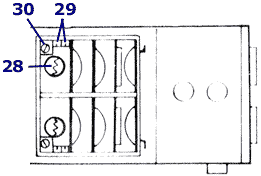
Remove a cover of a condenser, which one is arranged above lamps. Having pulled a lamp for a bottle hill up to take it from the cartridge. Paste into the cartridge a new lamp. In order to prevent occurrence fatty of spots on a bottle of a lamp, which one at heating will call tarnishing a glass, it is necessary to use a napkin.
Make regulation of a lamp. For this purpose paste into a personnel window the keeper of slides and establish in it "a dead" cardboard slide with 2-3 mm hole opening in center. Switch-on ventilating the device and new lamp. Put a sheet of a paper before a lens for observation of threads of a lamp. With the help of a screwdriver, turning eccentrics 29 and screw 30 to achieve, that in the direct and return map of threads of a lamp on a paper uniformly spacefilled a field of a light spot.
Other lamp is similarly substituted also, if it has fused.
Put projector on a side, unscrew two legs and four screws retaining the lower grid. Remove belt from a sheave and exchange new of a complete set. Put a grid on a place.
Bend off four lugs 3 on a body of a bracket for a stereoprojection, remove the rim with polarization light filters and make their replacement from a kit of spares. Establish the spare rim with light filters, as is indicated in a figure then bend lugs.